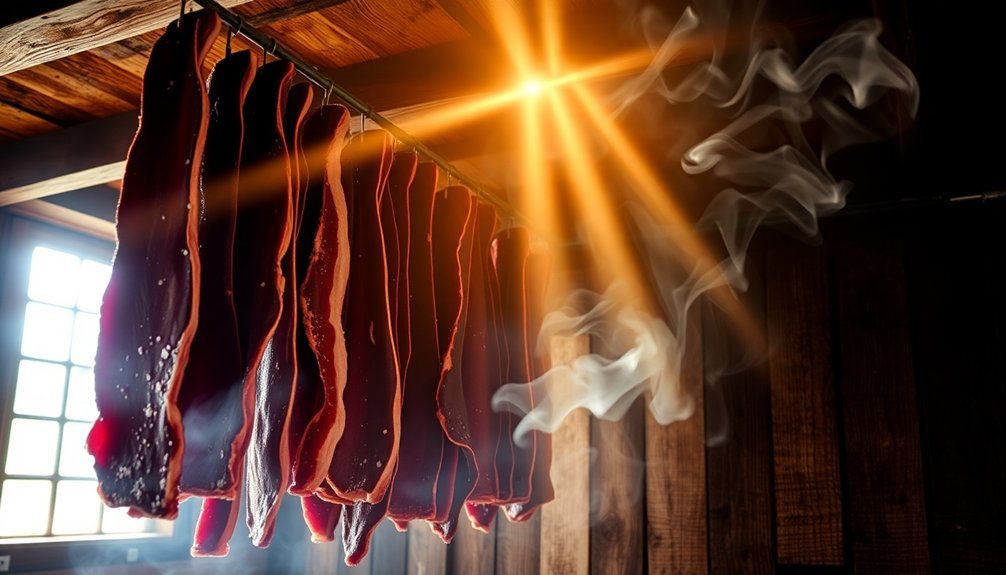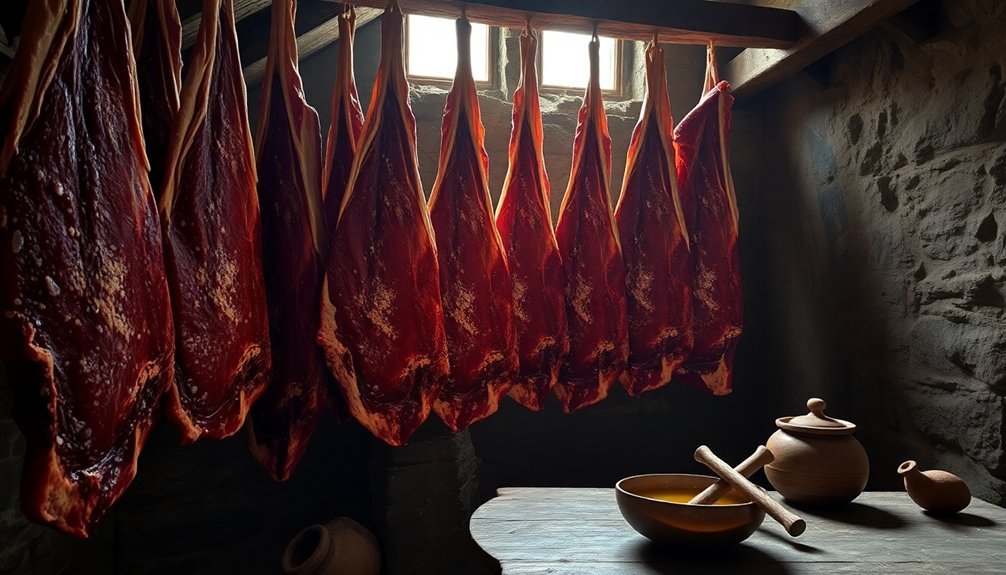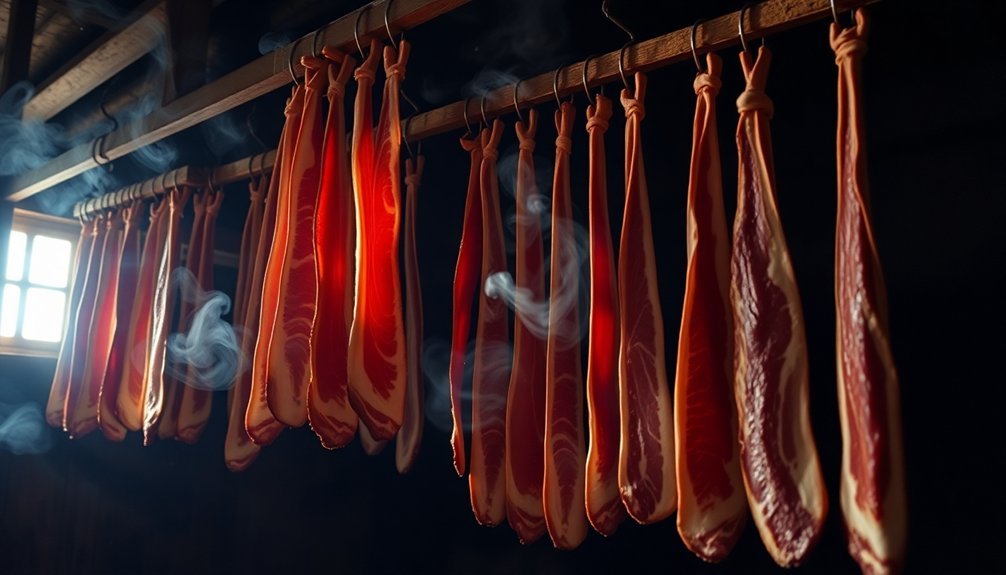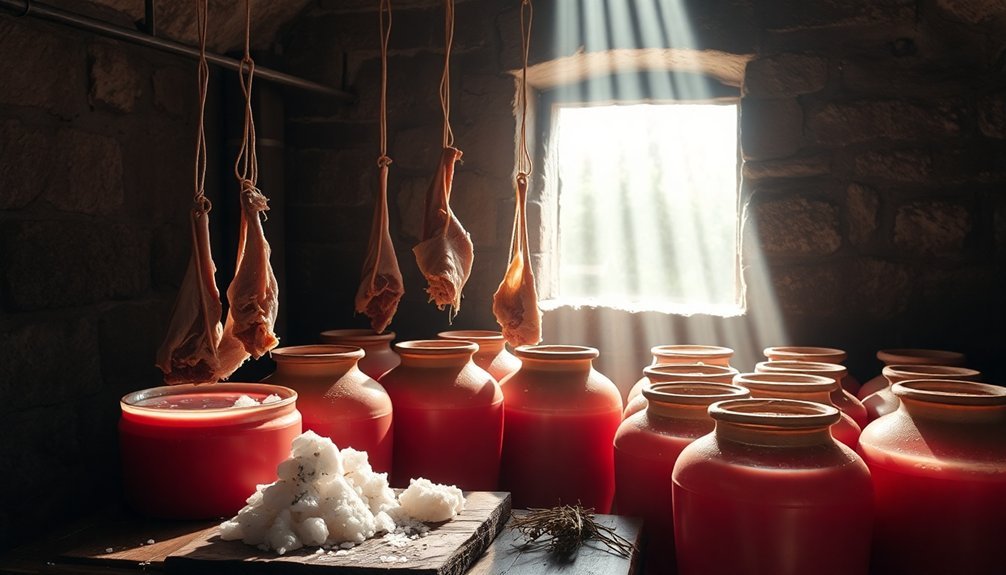Ancient civilizations developed several effective methods to keep meat fresh without electricity. You can preserve meat through salt curing, which draws out moisture and stops bacteria growth. Smoking meat creates an inhospitable environment for microorganisms while adding flavor. You'll find that drying meat in the sun and wind produces storable products like jerky. Fermentation techniques use beneficial bacteria to create an acidic environment that prevents spoilage. Natural ice storage and cold streams helped keep meat cool, while sealing with fats created airtight preservation. These time-tested techniques hold centuries of wisdom waiting to be discovered.
Understanding Traditional Meat Preservation

Throughout history, humans have developed several reliable methods to preserve meat without modern refrigeration. These time-tested techniques have helped civilizations maintain their food supplies and transport meat across vast distances, from the Roman Empire to pioneer settlements.
You'll find that traditional preservation methods fall into four main categories: curing and salting, smoking, brining and pickling, and preserving with fat and fermentation. Each method works by creating conditions where harmful bacteria can't thrive.
When you cure meat, you're using salt to draw out moisture and create an inhospitable environment for microorganisms. If you're smoking meat, you're using heat and smoke compounds to reduce surface moisture while adding flavor. With brining, you're soaking the meat in a saltwater solution that both preserves and tenderizes. The ancient Romans perfected curing as a way to safely transport meat across their vast empire.
You can also preserve meat by sealing it with fat, as seen in traditional foods like pemmican, or through fermentation, which uses beneficial bacteria to prevent spoilage.
These methods don't just preserve meat—they've shaped culinary traditions worldwide and continue to influence how we prepare and store food today.
Sun and Wind Drying
Among the oldest forms of meat preservation, sun and wind drying can be traced back to around 12,000 B.C. in the Middle East. You'll find evidence of ancient civilizations using these methods to preserve not just meat, but also fruits and grains, ensuring their communities had food during harsh seasons.
If you wanted to dry meat in ancient times, you'd lay thin slices on wooden slats or stones in sunny areas. You'd need to cover the meat with fine-weave cloth to protect it from insects, birds, and environmental contaminants. The thickness of your meat slices and their fat content would affect how well they dried. Low sunlight regions often had to adapt their drying methods significantly.
When sunlight wasn't sufficient, you'd use a "still house" with fires to create the necessary heat for drying. This gave you more control over the process than relying solely on weather conditions.
You could also combine drying with smoking for enhanced preservation.
While you couldn't control temperature and drying time precisely with sun drying, you could leave your meat in a cooling oven overnight to achieve the desired dryness. This method helped create products like jerky, which could be stored for extended periods.
Salt Curing Through Time

- Cover the meat completely with pure salt.
- Place it in a cool container until liquid stops seeping out.
- Rinse off excess salt after 5-14 days.
- Hang the meat in a cool, dark place to dry.
Salt draws out moisture and prevents harmful bacteria from growing, creating an environment where beneficial lactic acid develops.
The technique evolved when ancient civilizations discovered that adding saltpeter (potassium nitrate) enhanced the meat's color and flavor.
By the Medieval period, salt curing had become a widespread practice, and it wasn't until the late 1800s that people understood the science behind nitrates and nitrites in meat preservation.
Even today, you'll find these ancient methods still work effectively without modern technology.
Natural Ice Storage Methods
While salt curing proved effective year-round, ancient societies also mastered the art of using nature's refrigerator – ice and snow. In cold climates, you'd find communities harvesting ice from frozen lakes and rivers during winter months, storing their precious cargo in specially designed icehouses. They'd pack the ice carefully in straw or sawdust, creating an insulated environment that kept the ice from melting too quickly.
If you lived in mountainous regions, you'd likely take advantage of naturally cold caves and cellars, where consistent cool temperatures helped preserve your meat. You could also bury your wrapped meat directly in snow or ice, protecting it with animal hides to prevent direct contact with the elements. This method was particularly useful in areas where other preservation techniques weren't practical.
Before modern refrigeration, you'd rely heavily on iceboxes – the predecessors of today's refrigerators. You'd store blocks of harvested ice in these insulated boxes, creating a cool environment that kept your meat fresh.
The ice's quality mattered greatly – clearer, purer ice lasted longer and provided better preservation results.
Smoking Meat for Longevity

You'll find smoking to be one of humanity's oldest and most effective methods for preserving meat, offering both antimicrobial protection and distinctive flavors.
Whether you're using cold smoking for long-term storage or hot smoking for immediate consumption, the process creates an inhospitable environment for bacteria while infusing your meat with complex flavors from woods like apple, sugar maple, or lilac.
Traditional wood smoking techniques require careful temperature control and proper humidity levels, with cold smoking maintaining temperatures below 100°F and humidity between 90-95% for ideal preservation.
Smoking Methods and Benefits
Meat's remarkable preservation through smoking stands as one of humanity's oldest and most effective food storage methods.
You'll find that smoking creates an acidic barrier on the meat's surface while reducing its water content, making it naturally resistant to bacterial growth. When combined with curing salts, smoking becomes even more effective at extending shelf life.
You can choose from three main smoking methods:
- Cold smoking (16-22°C, 90-95% humidity): Perfect for salmon and cheese, providing maximum preservation through antimicrobial phenols.
- Warm smoking (23-40°C, 70-90% humidity): Ideal for chicken, beef, and pork, balancing preservation with cooking.
- Hot smoking: Less preservative effect but enhances flavor while cooking the meat.
Each method affects the meat's final taste and texture differently.
When you properly smoke and store meat, it can last up to six months without refrigeration.
You'll want to keep it in a cool, dry place, away from sunlight and moisture.
Watch for signs of spoilage like sliminess, discoloration, or foul odors.
Traditional Wood Smoke Techniques
Traditional wood smoking techniques have evolved over thousands of years, building on our ancestors' wisdom in meat preservation. You'll find two main approaches: cold smoking below 32°C (90°F) for preservation, and hot smoking above 32°C (90°F) for flavor and cooking. The wood you choose greatly impacts the final product.
| Wood Type | Best Used For |
|---|---|
| Apple Wood | Pork, Poultry |
| Sugar Maple | Bacon, Ham |
| Juniper | Flavor Accent |
| Lilac | Seafood, Cheese |
| Conifer | Avoid – Bitter |
When you're smoking meat for preservation, you'll want to maintain temperatures between 16-22°C (61-72°F) with high humidity for cold smoking. This process can take several days but effectively removes moisture while adding protective phenols and antimicrobial compounds from the smoke.
You can store your smoked meat in the refrigerator for up to 4 days once opened, or freeze it for 3-6 months. For best results, vacuum seal your meat and keep it in a cool, dark place. Remember that fattier cuts like brisket typically last longer than lean meats like salmon when properly smoked and stored.
Fermentation in Meat Preservation
You'll find that fermentation stands as one of humanity's oldest meat preservation techniques, dating back to Paleolithic times when our ancestors discovered that certain bacterial cultures could safely transform raw meat into long-lasting food.
In traditional methods, you're letting beneficial bacteria convert meat's compounds while creating an acidic environment that keeps harmful pathogens at bay.
Whether you're making fermented sausages or following ancient recipes with specific spice combinations like coriander and amaranth, the process requires careful attention to temperature and time to guarantee the right microorganisms thrive.
Traditional Fermented Meat Methods
Throughout history and up to the present day, people have relied on fermentation as one of the most effective ways to preserve meat without modern refrigeration.
You'll find this traditional process focuses mainly on pork and beef, typically using an 80-20 ratio of lean meat to fat.
The key steps in traditional meat fermentation include:
- Cut meat into 2-inch cubes or grind it coarsely, letting the natural bacteria present in the meat drive the fermentation process.
- Maintain temperatures between 12-16°C (54-61°F) and high humidity levels of 82-98% during the 3-8 day fermentation period.
- Monitor the pH level, aiming for around 5.2 to guarantee proper preservation while avoiding overly sour results.
- Dry the fermented sausages at 12°C for 2-3 months before storage.
You don't need starter cultures or added sugars in traditional methods. Instead, you'll rely on the natural microflora present in the meat and environment.
The process works because fermenting bacteria produce acid, which lowers the pH and naturally prevents harmful microorganisms from growing.
You can store the finished product at 12-18°C with 75-80% humidity for up to six months.
Creating Safe Fermented Sausages
Safe fermented sausage production requires a careful balance of multiple preservation techniques working together. You'll need to start with high-quality meat, trimming away fat, sinews, and glands to minimize bacterial risks. For semi-dry sausages, use beef with a fine chop; for dry varieties, choose pork with a coarser texture.
You'll create multiple safety barriers by combining salt curing, pH control, and moisture reduction. Add both regular and curing salts to your meat mixture, then stuff it carefully to avoid air pockets.
Begin fermentation at room temperature, monitoring the pH until it drops below 5.3. You'll then move your sausages to a cooler space for 20-30 days of drying.
Control humidity carefully during the drying process, starting high at 98% and gradually decreasing it to stay 3-5 points below the sausage's internal moisture. You'll want to maintain light air circulation while the sausages dry from inside out.
For extra protection, add bio-protective cultures and smoke your sausages at appropriate temperatures: 22-32°C for semi-dry varieties and below 18°C for dry ones. Continue drying until water activity drops below 0.91.
Beneficial Bacteria's Preserving Power
Numerous ancient civilizations discovered that beneficial bacteria could transform raw meat into safe, long-lasting food through fermentation. These microorganisms, particularly lactic acid bacteria (LAB), create an environment where harmful pathogens can't survive by producing natural preservatives like lactic acid and bacteriocins.
When you ferment meat, you're harnessing the power of several key bacterial strains that work together to preserve your food:
- *Lactobacillus* species produce acids that lower the pH, making the environment hostile for dangerous bacteria.
- *Streptococcus thermophilus* helps develop flavor while fighting off pathogens.
- *Enterococcus faecium* creates powerful bacteriocins that act as natural preservatives.
- *Leuconostoc* species contribute antimicrobial properties that extend shelf life.
You'll find these beneficial bacteria naturally present in traditional fermented meats like Turkish sucuk and Tunisian dried ossban. They don't just preserve the meat – they also make it more nutritious by producing vitamins and breaking down proteins for easier digestion.
Ancient cultures took advantage of this process by storing meat in pits, under rocks, or in sealskin containers, where the bacteria could work their preservative magic in an oxygen-free environment.
Ancient Brining Techniques

Ancient civilizations mastered the art of meat preservation through brining, a technique that relied on salt's natural ability to prevent bacterial growth. In this process, you'd start by rubbing salt directly onto the meat to draw out moisture, then submerge it in a brine solution within wooden barrels.
You'll find that ancient peoples were quite clever with their storage methods. They'd seal the barrels carefully, sometimes using leather, clarified butter, or pig bladders to create an airtight environment. The containers were then stored in cool, dark places, where they'd regularly check for any signs of spoilage.
What made brining particularly effective was its versatility. You could preserve various types of meat, from red meat to fish and poultry, making it a go-to method for both short and long-term storage. The Romans used it extensively for meat transport, while colonial households relied on it to keep their meat fresh through winter months.
The best part? Brining didn't just preserve the meat – it kept it moist and flavorful, unlike simple drying methods. You could even combine it with other preservation techniques like smoking or curing for enhanced results.
Preserving With Smoke Houses
While brining offered one path to preservation, smokehouses emerged as a pivotal development in keeping meat edible for extended periods.
These specialized structures served dual purposes as both smoking facilities and storage units, using natural drafts to circulate smoke around hanging meats.
You'll find the smoking process relied on cold temperatures below 90°F, with meats hanging for up to two years in some cases.
The combination of smoke and salt curing created a powerful preservation method that's stood the test of time since prehistoric era.
Here's what made smokehouses so effective at preserving meat:
- Wood smoke contained phenols that acted as natural antimicrobial agents
- The slow drying process prevented harmful bacteria growth
- Smoke compounds helped prevent fat oxidation and rancidity
- The sustained exposure deterred insects and vermin
If you'd tried preserving meat in a traditional smokehouse, you wouldn't have had the luxury of controlling temperature, air speed, or smoke density like modern smokers do.
Instead, you'd have relied on time-tested techniques refined through generations, from ancient fire pits to medieval monastery practices, until refrigeration finally changed the game.
Traditional Cold Storage Solutions

Deep beneath the ground, traditional cold storage methods provided effective alternatives when smoking wasn't practical.
You'll find that our ancestors cleverly used natural cooling systems like underground pits, cellars, and caves to keep meat fresh for longer periods. These spaces maintained consistently cool temperatures and higher humidity levels that helped prevent meat from drying out too quickly.
If you're looking to understand their methods, you'll discover they often combined different techniques. They'd wrap meat in cloth or animal hides before placing it in ceramic pots or jars, sealing them with butter, lard, or tallow to create an airtight barrier.
For rapid cooling, they'd immerse meat in cold water or iced baths, particularly effective for poultry.
You can see how they maximized natural resources by storing meat in ice houses or ice cellars, utilizing winter's snow and ice for year-round cooling.
They'd also take advantage of cold streams and shaded areas, keeping meat submerged in running water or stored in cool, dark spaces.
The thick walls and earth flooring of cellars created natural insulation, maintaining stable temperatures essential for meat preservation.
Frequently Asked Questions
How Long Can Traditionally Preserved Meat Remain Safe to Eat?
You'll find properly preserved meat can last several months to over a year. When you use drying, smoking, curing, or fermenting techniques, and store it in cool, dark places, it stays safe to eat.
What Signs Indicate Traditionally Preserved Meat Has Gone Bad?
You'll know your traditionally preserved meat has spoiled if you notice a rancid odor, grayish-green discoloration, or slimy texture. Watch for mold growth and unusual texture changes before consuming preserved meats.
Can Traditional Preservation Methods Be Combined for Better Results?
You can definitely combine preservation methods like smoking with curing, or drying with salting, to achieve better results. It'll enhance both flavor and shelf life while providing more thorough protection against spoilage.
Which Meats Are Most Suitable for Ancient Preservation Techniques?
You'll find that lean meats like beef, venison, and fish work best for ancient preservation. They're easier to dry and salt due to lower fat content, which could otherwise turn rancid during storage.
How Do Seasonal Changes Affect Traditional Meat Preservation Methods?
You'll need to adjust your preservation methods based on the seasons. In summer, you're dealing with higher humidity and heat requiring faster curing, while winter's cold helps with natural preservation and smoking.
In Summary
You've now discovered several time-tested methods our ancestors used to keep meat edible long before electricity. Whether you're drying meat in the sun, curing it with salt, smoking it in a traditional smokehouse, or using natural ice storage, these techniques remain relevant today. You can still apply these ancient preservation methods to maintain your meat's freshness and even enhance its flavor while reducing your reliance on modern refrigeration.





Leave a Reply